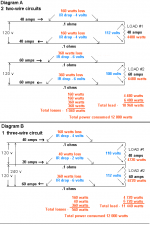Alwayslearningelec
Senior Member
- Location
- NJ
- Occupation
- Estimator
Had someone recently tell me whether or not you can share neutrals doesn't make much of a difference in terms of amount of wire/cable needed.
To me that makes no sense. If you must run separate neutrals for all your branch, you wind up with a lot more copper. At least in my experience.
To me that makes no sense. If you must run separate neutrals for all your branch, you wind up with a lot more copper. At least in my experience.


